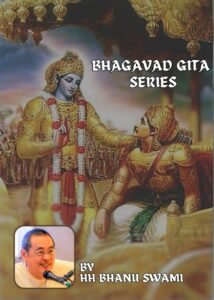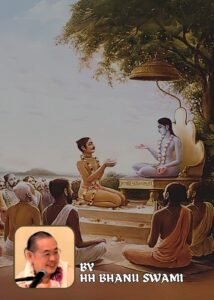Srimad Bhagavatam : 10.52.20~23 by HH Bhanu Swami Maharaj on Dec 1, 2024 @ ISKCON Japan
Text 20
brahman kṛṣṇa-kathāḥ puṇyā
mādhvīr loka-malāpahāḥ
ko nu tṛpyeta śṛṇvānaḥ
śruta-jño nitya-nūtanāḥ
Translation
What experienced listener, O brāhmaṇa, could ever grow satiated while listening to the pious, charming and ever-fresh topics of Lord Kṛṣṇa, which cleanse away the world’s contamination?
Text 21
śrī-bādarāyaṇir uvāca
rājāsīd bhīṣmako nāma
vidarbhādhipatir mahān
tasya pancābhavan putrāḥ
kanyaikā ca varānanā
Translation
Śrī Bādarāyaṇi said: There was a king named Bhīṣmaka, the powerful ruler of Vidarbha. He had five sons and one daughter of lovely countenance.
Text 22
rukmy agrajo rukmaratho
rukmabāhur anantaraḥ
rukmakeśo rukmamālī
rukmiṇy eṣā svasā satī
Translation
Rukmī was the first-born son, followed by Rukmaratha, Rukmabāhu, Rukmakeśa and Rukmamālī. Their sister was the exalted Rukmiṇī.
Text 23
sopaśrutya mukundasya
rūpa-vīrya-guṇa-śriyaḥ
gṛhāgatair gīyamānās
taṁ mene sadṛśaṁ patim
Translation
Hearing of the beauty, prowess, transcendental character and opulence of Mukunda from visitors to the palace who sang His praises, Rukmiṇī decided that He would be the perfect husband for her.
Purport
The word sadṛśam indicates that Rukmiṇī and Śrī Kṛṣṇa had similar qualities and thus were naturally attracted to each other. King Bhīṣmaka was a pious man, and therefore many spiritually advanced persons must have visited his palace. Undoubtedly these saintly persons preached openly about the glories of Śrī Kṛṣṇa.
HH Bhanu Swami Maharaj :
The present verse 20 is discussing about Krishna katha, topics of Krishna. In one sense, of course, the whole Bhagavatam is Krishna-katha. However, we do have the direct description of the pastimes of Krishna also. Of course, we can say everything is a pastime of Krishna because he’s controlling everything ultimately. So we have creation, destruction of the material world, these are pastimes of Mahavisnu, who is expansion of Krishna.
We have Brahma creating all the living entities in the planetary systems. Again, he’s expansion from Krishna. And even we have descriptions of Yamaraja punishing people, so Yamaraja is empowered by Krishna to do that. So we can call all this, Krishna-katha, topics about Krishna. However, the devotees of Krishna actually prefer to hear about Krishna’s interaction with His devotees. And thus many devotees are more interested in 10th canto of Bhagavatam which directly describes Krishna in Vrindavan and in Mathura and Dwaraka.
So this verse 20 talks about Krishna-katha being very punya, which literally usually we say is piety. However, topics or things related to Krishna are not material punya. Of course, they give material good results also, but ultimately the results should be spiritual. Another meaning of the word punya is pure. In Bhagavad Gita, the word punyagandha, fragrance, so that means it’s a pure fragrance, not just a pious fragrance.
So, of course, we can say pure means also purifying, it helps to purify people while hearing the topics of Krishna. And everything that Krishna does is beyond the material world. All of Krishna’s pastimes are uncontaminated by the three gunas of material nature. So, if we hear the topics of Krishna, we should not project material conceptions on those topics. For instance, people, if they see Krishna and the Rasalila, they will think of material things.
Why Krishna is dancing with the gopis in the middle? That’s not nice. That’s not dharmic. Spiritual activities are beyond dharma and adharma.
Everything the Lord does is perfect and completely pure. Of course, to understand the pastimes of Krishna requires some qualification. Otherwise, we will misunderstand those pastimes. Related to this, it also says that these pastimes will destroy all material contamination. What is the material contamination? Material contamination means that all human beings in this material world are covered by ignorance. And due to that ignorance, the Jiva begins to think, he is a material body. And the material body wants to enjoy material objects in this world. So, this is the contamination, “mala” that is mentioned here.
Of course, if we are living in the material world, we say, what’s wrong with the material world? What’s wrong with enjoying? But of course, from another point of view, we have a pig in his pig pen. He’ll say, what’s wrong with me living here? I’m eating and enjoying very nicely in my pig pen. We have the chicken in his cage also. I’m eating my grains or whatever. What’s wrong? So, a human being looks like he’s not in a cage, or he’s not here in jail, but still, the whole world is a cage. However, it’s a very big cage. And it’s decorated very nicely, so you don’t think it’s a cage. Nevertheless, everyone in the material world is stuck in this cage.
And they’re forced into material bodies, which are subject to all sorts of pains, and ultimately die. So unfortunately, because of maya, we don’t think it’s a prison, we think it’s tolerable. To get out of the prison, we have to destroy the attachment to the prison.
So the scriptures provide us with methods, Jnana Yoga, Astanga Yoga, and Bhakti Yoga. So Bhakti Yoga is the easiest way to destroy this contamination. And in Bhakti Yoga, we have the process of hearing the topics of Krishna. This is a very powerful way of destroying that contamination. What makes it so powerful? And one of the reasons described here is “madhvih”, very sweet. So the pastimes of Krishna are very attractive, because of their sweetness. And therefore, the person who hears them becomes very satisfied.
So everybody likes to eat. But they like to eat tasty food. Unfortunately, in the material world, anything that’s tasty, eventually we eat too much, it’s no longer tasty. So that’s the word at the end, it’s “nitya-nutanah”, it is ever fresh. So it’s sweet, but if we keep listening, it becomes sweeter. So this is because it is spiritual, spiritual things, they increase their sweetness.
So this particular pastime is the pastime of Rukmini. So it describes how Rukmini became attracted to Krishna. She never saw him, but simply about hearing about him, hearing his pastimes, which are ever fresh, full of sweetness, ever punya, destroy all contamination, simply by that, she wanted to marry Krishna.
So this is a story concerning madhurya rasa. Of course madhurya means sweet. So this relationship between Rukmini and Krishna is a very sweet relationship. So from Rukmini’s point of view, of course, it is very satisfying, because Krishna responds to her devotion. So Rukmini never saw Krishna, but she heard the topics of Krishna, and these were very sweet, very fresh, very attractive.
But for us, we hear this whole pastime, Rukmini and Krishna. It also is very sweet, very attractive, very purifying. In terms of Rukmini, as I said, she never saw Krishna, but hearing about him, she developed this great attraction.
So in madhurya rasa, this is the first stage. It’s called purva raga. The madhurya rasa gets stimulated even without seeing Krishna directly. Then at a certain time, there is a direct meeting where the devotee can meet Krishna and speak to him. So similarly in Vrindavan, before the rasa lila, the gopis didn’t actually directly speak with Krishna, so they had this purva raga developed. In other words, the attraction is there even before meeting.
Of course, not only in madhurya rasa, such sentiments also exist in other rasas. For instance, in Mathura, the people there did not meet Krishna until he was 11 years old. And then when Krishna came there to kill Kamsa, finally they saw Krishna. However, before he came there, people began to hear about Krishna. So they began to hear about Krishna killing different demons and having different pastimes, and they started getting attracted. And then finally when Krishna came there to kill Kamsa, everybody saw Krishna and they were very happy.
So everyone developed attraction to Krishna because of hearing. And when the attraction was strong enough, then Krishna appeared. So similarly, we have to develop our attraction to Krishna by hearing about him. And then finally, Krishna makes his appearance.
Okay, Hare Krishna.
Q & A
1) Maharaj, this shloka mentions that Rukmini had the same qualities as Krishna. Could you explain aout this point?
Not literally, it was. Obviously, if the same qualities are there exactly, then she’s non different from Krishna. But to develop attraction, there must have some similarity.
So there are some common qualities, which are the cause of further attraction. So, the similarity must be there to develop that attraction, to develop rasa. And that is why our acharyas has explained, we do not have rasa between a human being and a plant or a human being and an animal. So, the full expression of one’s relationship can only take place between two human beings.
Of course, people can argue, well, I love my horse, I love my dog, I love my cat. We’re different, but we have a loving relationship. However, it’s never a satisfactory relationship for a human relationship. Probably, they develop that relationship with animals because they are dissatisfied, they don’t have a human relationship. Of course, we can have relationships, but the relationships cannot develop to a high degree to produce rasa.
So, rasa is more than just an affectionate relationship. It involves exchange of words that require intelligence. In order to experience rasa, then they have to express themselves nicely in words. In the case of Rukmini, she starts writing letters to Krishna.
So, we can’t do such things with an animal. Write a letter to your dog and get a reply from the dog. You write love letters to the dog, all he’ll do is bark. So, there’s a limit of how we can communicate with people who are not our species.
However even if we are human species, still different people have different habits, different ways of expressing etc. So, we have to have some common ground also on how we communicate, how we use words etc, otherwise, we won’t establish a relationship.
So, in tradition of India, they take care of that, by marriage within varna. So within that particular caste of Varna, there’s enough similarity of communication, words, likes and dislikes, that they can establish a relationship.
In this case, of course, we have Kshatriya with Kshatriya. So, there was that similarity there. Of course, the ultimate similarity is that Krishna is the Supreme Lord and Rukmini is the Shakti of the Supreme Lord, so there’s great similarity there.
So, the Shakti and the Shaktimaan are different and non-different. So, we often say that Radha and Krishna are one, but also there’s enough difference to separate them. So, the same with Rukmini.
2) It is quite interesting topic. What is the difference between material and spiritual relationship? Even sometimes in material world, there are very nice couples with same varna etc they somehow very nicely relate, communicate and get satisfaction. So, how then the transcendental communication is different and higher than material relationship?
So, in the material world, we try for best combinations, but everything is imperfect, because it’s material. So, in the material world, we have rasa. But simply because it’s the material world with material bodies, it can never be eternal. No matter how perfect the relationship maybe, it must end, because there will be a death. So, the relationship is there, maybe as sweet as possible, but then it will end with separation and there will be no more union at all. That’s the problem.
And we have to search for a good combination. It may be possible or whatever, but often it’s not proper and there will be suffering because of that. So, the secondary rasas become more prominent than the primary rasas.
So, fear, lamentation and anger become more prominent. So, in the spiritual world, everything is eternal, and there’s a natural relationship between the jiva and supreme lord. If there were not a natural relationship, they wouldn’t be there. And if there are secondary rasas in the spiritual world, they’re always in a secondary position. And they support the primary rasas.
3) Maharaj, you mentioned about different rasas and Madhurya-rasa and Purva-raga, etc. So, I was wondering, in different yugas, like Satya-yuga and Krita-yuga, we see many exalted devotees like Prahlad Maharaj, Dhurva Maharaj, Hanuman, etc. And they are serving Lord in awe and reverence, like in Vatsala, in servant mode. But in our Gaudia Parampara / Sampradaya, we see that, since Mahaprabhu and all the six Goswamis, they introduced and emphasized on this Madhurya-rasa. But we know that Kali yuga is very degraded, in such degraded condition, why they have emphasized and introduced such an exhalated and topmost rasa?
So, it is true that Madhurya-rasa with Krishna, is very high. And it is also very rare. But it is also the most blissful. People of Kali-yuga are most unqualified. However, sometimes, the Lord is very merciful.
And he wants to give the highest treasure to the lowest people. So, Lord Chaitanya is that form of the Lord who is most merciful. So, he offers this Madhurya-rasa to the people of Kali-yuga through Nama-sankirtana.
4) Maharaj, we are full of envy and controlling nature. And most of the devotees, I mean, you mentioned in your previous lectures that most of the devotees are in Vaidhi-bhakti. So, in such a stage, can we actually relish this Purva-raga or Madhurya-rasa pastimes, Maharaj?
So, the process of hearing is such that, by hearing we can develop attraction for Krishna’s pastimes in Vrindavan. So in other words, we begin to aspire to follow the inhabitants of Vrindavan. But externally of course, we may still follow the rules of Vaidhi bhakti, but our attraction is for, a relationship with Krishna which is beyond those rules. So, that attraction will develop, by hearing about those pastimes.
5) In other words, can we say – externally we have to follow Vaidhi and internally Raganuga?
Yeah, you can do that. Actually, many aspects of Raganuga are internal. So, Smarana, which is remembrance of the Lord in his pastimes, is one of the prominent angas of Bhakti there. Rupa Goswami says, we have the external service we do, with the material body, and we have the internal service we do, with our spiritual body or almost spiritual body. In the external body, they act like normal persons, like Goswamis. Internally, they operate serving Krishna with their spiritual body.
6) Today you have mentioned about Rasa. It is beyond material, and one has to use words and intelligence. Krsna learned about this poetic expression from Sandipani Muni. So, could you explain about where they used words and intelligence to express it?
We have many examples of that in the case of Rukmini here. Later on, there is a story of how Krishna joked with Rukmini and then she fainted and then this and that. So, there is a whole dialogue between Rukmini and Krishna.
Krishna says, I’m not a good husband. I ran away from the battle. I hid in the ocean, making a fort here. I’m very unqualified, whatever. And then Rukmini replied using the same words, but she gave another interpretation of each word he said, so that it became the opposite. So she refuted all of Krishna’s arguments.
The same thing.. when Krishna played his flute and the gopis came to the Raslila. Krishna said, Oh, you better go home. It’s dangerous in the forest. I’m a brahmachari. It’s going to cause a big scandal, so go home. And then the gopis replied, and they answered every point he made by making a new point, and they defeated him.
7) Maharaj, this kind of poetic technique books, do you have?
Well, the examples are there in the Bhagavatam itself. In the Ujjwala Nilamani, Rupa Goswami quotes all the different use of words that the gopis or Krishna use, and how they can cleverly use those words to mean other things.
8) Why in verse 23 (10.52.23) he uses the word Mukunda?
So often, various words are used for Krishna such as Achyuta, Mukunda, Madhava, etc. So, of course, they do have meanings, these words. So, one meaning of the word Mukunda is, he gives liberation. Of course, here the mukti is not literal liberation, but liberation from getting married to the wrong person Sisupala or some one else, as Krishna freed her from that bondage.
9) Maharaj, I have a question about the qualities. Sri Radha and Krsna, they have 64 transcendental qualities and they experience topmost relationship. But how a living entity develops some of those qualities, can they have relationship with Krsna ? or unless they develop all the transcendental qualities they cannot establish relationship with Krsna ?
So, certain qualities are only for the Supreme Lord. So generally the Jivas can develop 50 qualities. And even those 50 qualities, will be very little bit, not much. These qualities will develop, according to their particular relationship with Krishna.
Devotees: Grantharaj Srimad Bhagavatam Ki.. Jai ! Srila Prabhupad Ki.. Jai !! HH Bhanu Swami Maharaj Ki.. Jai !!


